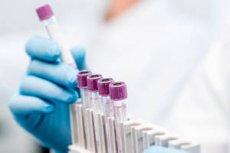Proteins in blood may warn of cancer more than seven years before diagnosis
Sist anmeldt: 14.06.2024

Alt iLive-innhold blir gjennomgått med medisin eller faktisk kontrollert for å sikre så mye faktuell nøyaktighet som mulig.
Vi har strenge retningslinjer for innkjøp og kun kobling til anerkjente medieområder, akademiske forskningsinstitusjoner og, når det er mulig, medisinsk peer-evaluerte studier. Merk at tallene i parenteser ([1], [2], etc.) er klikkbare koblinger til disse studiene.
Hvis du føler at noe av innholdet vårt er unøyaktig, utdatert eller ellers tvilsomt, velg det og trykk Ctrl + Enter.

In a recent study published in Nature Communications, UK researchers examined the links between 1,463 plasma proteins and 19 types of cancer, using observational and genetic approaches in participants from the UK Biobank. They found 618 protein-cancer associations and 317 cancer biomarkers, including 107 cases detected seven years before cancer diagnosis.
Proteins play key roles in most biological processes, including cancer development, and several are known risk factors or biomarkers for cancer. While previous studies have identified individual proteins associated with cancer, new multiplex proteomics techniques allow the simultaneous assessment of proteins on a large scale, especially those that remain unstudied in the context of cancer risk.
Prospective studies face challenges due to confounding and bias, but genetic variations affecting protein levels provide additional evidence. Genetic predictors, especially cis-pQTL (protein quantitative trait loci), provide reliable evidence of associations between proteins and cancer. Integration of observational and genetic approaches increases the likelihood of identifying proteins that may be causally related to cancer development and progression.
This combination method helps to better understand cancer biology, identify therapeutic targets, and discover diagnostic biomarkers. Therefore, in this study, the researchers used an integrated multi-omics strategy combining prospective cohort and exome analyzes to identify proteins potentially involved in the etiology of cancer.
The study used data from the UK Biobank, a prospective cohort of 44,645 adults (after exclusion), aged 39 to 73 years, with a median follow-up of 12 years. Participants completed an assessment that included a questionnaire, anthropometric measurements, and blood sample collection. Plasma samples were analyzed using the Olink Proximity Extension Assay to quantify 1463 proteins. Data on cancer registration and death were obtained through linkage to national registries. Exome sequencing data were used to study genetic associations with protein levels.
Results and Discussion Observational analyzes showed 4921 cancer cases with a median age of 66.9 years. People who developed cancer were found to have higher rates of age, higher levels of addictions, and a family history of cancer compared to the overall analysis sample. Women with cancer had fewer children, earlier onset of menstruation, higher rates of postmenopausal status, use of hormone replacement therapy, and no use of oral contraceptives.
A total of 371 proteins showed significant associations with the risk of at least one type of cancer, resulting in 618 protein-cancer associations. Of these associations, 304 were associated with proteins enriched in mRNA expression in candidate cancer tissues or cells of origin. Most associations were found for proteins associated with hematological cancers with high mRNA expression in B cells or T cells, but associations were also identified with proteins with high mRNA expression in various other tissues, such as liver, kidney, brain, stomach, lungs, colon, esophagus and endometrium.
Hematologic malignancies, including non-Hodgkin's lymphoma (NHL), diffuse large B-cell non-Hodgkin's lymphoma (DLB-cell non-Hodgkin's lymphoma), leukemia, and multiple myeloma, accounted for more than half of the associations identified.
Significant associations included TNFRSF13B and SLAMF7 with risk of multiple myeloma, PDCD1 and TNFRSF9 with risk of NHL, and FCER2 and FCRL2 with risk of leukemia. Additionally, associations have been found with liver cancer (eg, IGFBP7 and IGFBP3), kidney cancer (eg, HAVCR1 and ESM1), lung cancer (eg, WFDC2 and CEACAM5), esophageal cancer (eg, REG4 and ST6GAL1), colorectal cancer (eg, AREG and GDF15), gastric cancer (eg ANXA10 and TFF1), breast cancer (eg STC2 and CRLF1), prostate cancer (eg GP2, TSPAN1 and FLT3LG), endometrial cancer (eg CHRDL2, KLK4 and WFIKKN1) and ovarian cancer (eg DKK4 and WFDC2).
Fewer associations were found for pancreatic, thyroid, melanoma, or lip and oral cancers. Pathway analyzes suggested that the adaptive immune response may play a role in hematologic cancers. Minimal heterogeneity was found after stratifying associations by gender.
A total of 107 protein-cancer associations remained significant seven years after blood sampling, and genetic analyzes supported 29 of them. Additionally, four associations were supported by both long-term data (>7 years) and analyzes involving cis-pQTL and exome protein genetic scores (exGS): NHL was associated with CD74 and TNFRSF1B, leukemia with ADAM8, and lung cancer with SFTPA2. The results identified 38 proteins associated with cancer risk that are also targets of currently approved drugs, indicating their potential therapeutic use to reduce cancer risk.
Although this is the largest cohort study examining circulating proteins and cancer, the analysis was limited to baseline protein levels, which may have led to underestimation of risks due to regression bias to the mean. Power was also limited for rare cancers and underrepresented populations, requiring further studies in diverse cohorts.
In conclusion, the study found several links between blood proteins and cancer risk, many of which were discovered seven years before cancer diagnosis. Genetic analyzes have confirmed their potential role in cancer development. Additionally, the results may help identify proteins that may contribute to early detection of cancer stages in people at risk, offering promising biomarkers for early diagnosis and improved patient outcomes.
